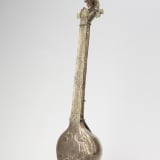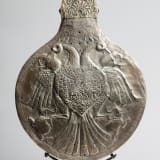



A Tambura for a court musician
17th century
India, Deccan, Karnataka
97 x 23.5 x 19 cm; Karnataka-style tanpura; a long necked string instrument, or unfretted drone lute; brass alloy; hammered in two parts and attached at the middle of the bridge; the resonator with holes for four strings; the peg bridge with pierced holes and three tuning pins.
This tanpura or tambura is an example of the type of long, stringed Indian drone lute intrinsic to the Indian classical music tradition (fig. 1). Etymologically, the word for tanpura derives from two words: tana meaning ‘musical phrase’ and pura meaning ‘complete’. The so-called ‘complete musical phrase” generated through the playing of the tanpura is an essential part of folk and classical Indian music: the instrument is chiefly known for producing the harmonic basis or “drone” of Indian classical music.









